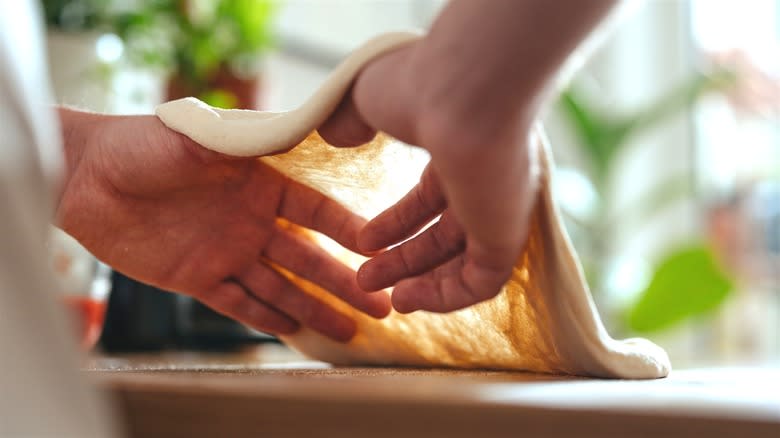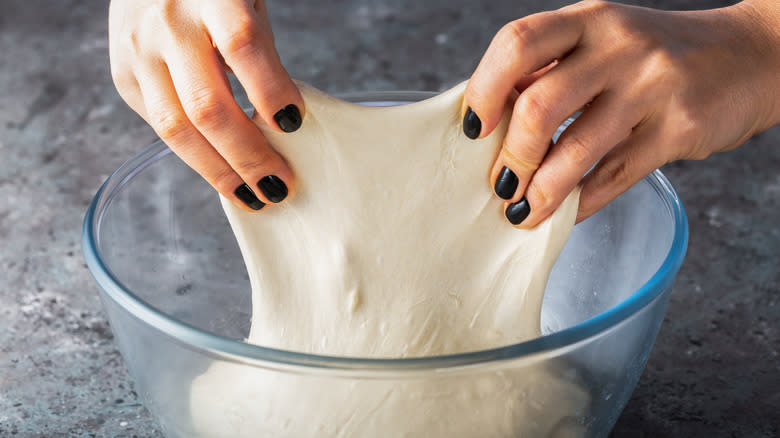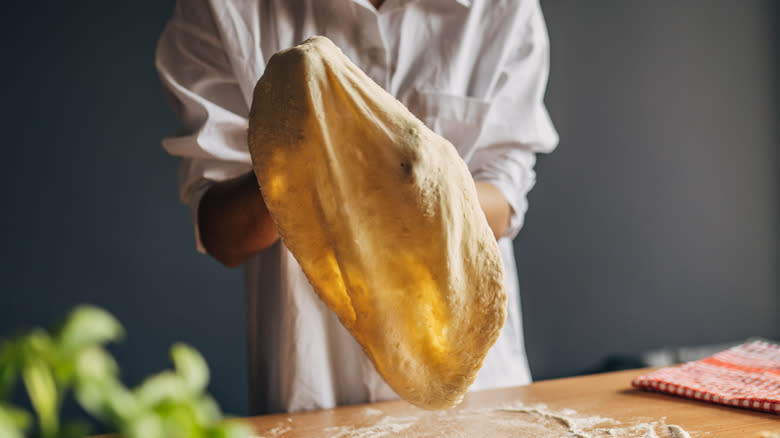The Secret To Stretching Pizza Dough For Restaurant-Quality Results

There's nothing more comforting and crowd-pleasing than a tasty homemade pizza, but making a perfect pie is not always as easy as it looks. Arguably, the most challenging part of making your own pizza from scratch is stretching the dough. To prevent the dough from sticking to your hands and your work surface, it's common to pour flour on your cutting board and over your ball of dough. However, you may want to think twice before reaching for your flour -- too much of it will actually ruin your dough, so opt for olive oil instead.
Before you begin stretching your dough, spread a thin coating of olive oil on your cutting board (you may also want to apply a few drops to your hands for good measure). The olive oil serves multiple purposes: It prevents your dough from sticking to your work surface and hands, it makes it easier to stretch, and it helps create a beautiful golden brown crust with tremendous flavor.
Dusting your cutting board and hands with too much flour will dry out your dough. It will make it difficult to stretch and likely result in a dense, stiff crust. You'll be amazed at how well olive oil works in its place for stretching your pizza dough. Follow a few other useful tips and you'll be well on your way to stretching pizza dough like a pro in no time.
Read more: 11 Of The Best Cooking Tips From Bobby Flay
Preparing Your Dough For Stretching

Pizza dough that is stretched perfectly will have an even consistency -- in other words, it will have the same amount of thickness throughout with no holes, and ideally a nice round or rectangular shape, depending on your preference. To start with, it's important to have the ideal amount of gluten to stretch your dough properly. When water is added to flour, proteins in the flour form gluten, which occurs naturally in many grains and gives chewiness and shape to food. Pizza flours typically contain 9 to 15 percent gluten-forming proteins, with the higher percentage making for a stiffer, tougher dough and the lower content resulting in a softer dough.
When it comes to stretching your pizza dough, too little gluten can make your dough soft and unable to hold its shape, while a very high gluten content will make your dough too elastic, frustratingly causing the dough to shrink after stretching it. Kneading the dough is crucial for strengthening the gluten networks, just don't over-knead it -- about 5 minutes is all it takes. It's also crucial to allow your dough to rest before stretching it to its final shape to allow the gluten to relax. When the gluten is too tight, the dough will simply tear when you try to stretch it. You can let your dough rest in a bowl on the counter at room temperature for a couple of hours or cover it and put it in the fridge overnight.
More Helpful Dough Stretching Tips

If you've rested your dough in the fridge, then remember this simple solution to keep your pizza dough from shrinking: Allow it to reach room temperature before stretching it. Stretching cold dough will result in the ultimate frustration as it will continue to snap back into a ball. When your dough has been properly kneaded, rested, and is at room temperature, it's ready to be stretched. After coating your cutting board with olive oil, lay the dough ball on top and press it flat with your palms. Use your fingers to flatten the dough from the center outward, leaving the perimeter thicker than the middle to create a dense, puffy crust.
Keep in mind that it's a mistake to roll out your pizza dough. While you might be tempted to use a rolling pin to stretch the dough, doing so will eliminate the air bubbles that make the crust airy and delicious. Instead, stick with your hands and use gravity to help stretch the dough -- lift half the dough with the back of your hands (the other half still sitting on the cutting board), allowing the dough to gently pull and stretch thinner. If you stretch it so thin that you end up with a hole or two, use your fingers to stick the dough back together. With some olive oil, properly prepared dough, and a few hand techniques, you'll be eating restaurant-quality pizza in no time.
Read the original article on Daily Meal

